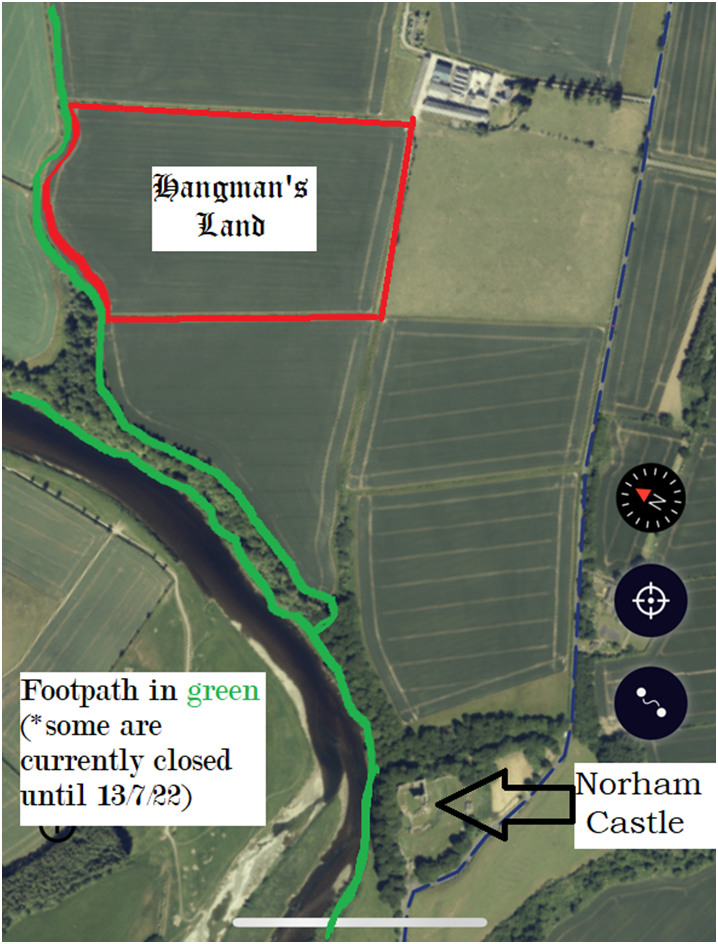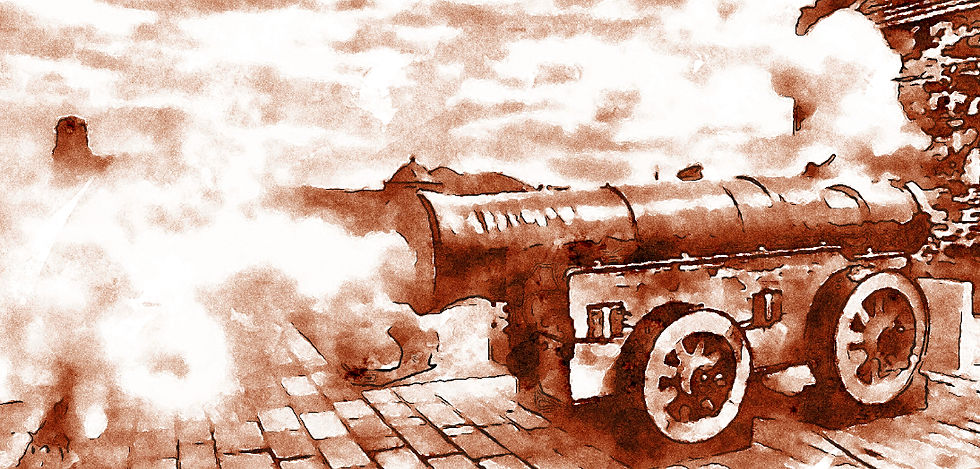Hangman's Land
- Norham Life
- Feb 5, 2022
- 3 min read
Recently I was looking at an old OS map of Norham and the surrounding areas which was kindly gifted to me and I noticed a patch of land slightly to the north east of the castle which is named as Hangman’s land. Cross referencing this with a modern day map the area still has the same name.
I enquired about this with some of the locals and received some interesting information about it—many thanks for the input.
As with all blogs published they are written with the best of intentions. Highlighted in green below are discrepancies of which I have been notified.
Below is an aerial view of Hangman’s land.
There is a public footpath that goes by the edge of Hangman’s Land field; however the path along the river by the castle is currently closed until mid July 2022 for safety concerns due to the felling of trees caused by storm Arwen in November 2021.

In historical terms a 154 years is not a particularly long time. If you rewind the clocks back to the 26th May of 1868 Fenian Michael Barrett was the last person to be publicly hanged in the United Kingdom for his participation in the Clerkenwell explosion which had killed a dozen people.
In this area Grace Griffin was the last person to be publicly hanged at Gallows Knowe, Berwick-Upon-Tweed in 1823.
Below is a link from a local newspaper dated 2017.
The last person hanged for a crime in a UK prison was in August 1964. However the passing of a death sentence was available as a punishment until its complete abolition in November 1998. One such reason was Treason for assisting the enemy which is interesting as this is a possible naming for the Hangman's Land here.*
To try and determine where Hangman's Land gets its name I used the online resource that Liz Towner has written about in her excellent mini series of blogs called 'Naming Norham'. See the link below.
The gallows in the village were located near Galagate Farm which I am informed is old wording for ‘Gala’ (abbreviation of Gallows) and ‘Gate’ (is the old word for a road or street). "Gallows Road."
* (1) Galagate, Norham Parish, page 24. https://namebooks.org.uk
“It is traditionally supposed that there was a Gate here at the entrance of Town in former times, from which a gallows was suspended – hence the name.”
* (1) This is highly unlikely as no defensive walls have been found there. If it were a gate, it would have been a toll bar which wouldn't have any structure to support a hanging.
One theory is that the Hangmen were awarded small pockets of land as payment for this particular grim vocation and another is that a traitor betrayed Norham Castle into the hands of the enemy. *Still punishable by death until November 1998!
Hangman’s Acre, Warkworth Parish, page 18
“the Vicar of the Parish supposes this to have been part of the salary attached to the Office of Hang man of the Borough in ancient times”.

Below is an extract from, (Disclaimer - RootsWeb.com Home Page. The WorldConnect Project allows users to upload, modify, link, and display their family trees as a means to share their genealogy with other researchers.
*(2) In 1513 James IV invaded England in the campaign which led to the disaster of Flodden. He attacked Norham using the mighty cannon "Mons Meg". The castle was soon in ruins and the garrison surrendered. There is a tradition that the castle was won through the treachery of one of the inmates who advised the king to descend from Ladykirk Band to Gin Haugh, a piece of flat ground near the river and to attack the corner wall there with his cannon.
*(2) Mons Meg was used in 1497 not 1513.

(A Mons Meg cannon image. Designed by Jehan Cambier in June 1449 used by the Kingdom of Scotland and sent as gift to James II in 1454.)
"So when the Scots the walls had won And rifled every nook and place, The traitor came to the king anon, But for reward met with disgrace. "Therefore for this thy traitorous trick Thou shalt he tried in a trice; Hangman, therefore,' quoth James, 'be quick; The groom shall have no better price'." -Ballad of Flodden.
*(3) A field north of the castle, called "Hangman's Land", is said to be the place of his execution.
*(3) The traitor who killed the gate porter to let in the Scots was actually around in 1318 when Robert the Bruce besieged Norham Castle for nearly a year. Walter Scott took that story, and that of Sir William Marmion out of the 14th century and put them both at the time of Flodden. The actual events are told in The Scalacronica written in the 14th century by the son of Sir Thomas Grey who was Captain of the Castle when it happened.
The name given to Hangman's Land Norham—salary of the Hangman, site of an executed traitor or something else?




Comments